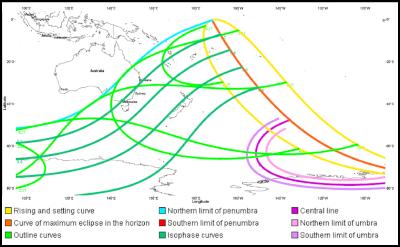Society shows eclipse to Christchurch community
Canterbury Astronomical Society shows eclipse to the Christchurch community
Members of the Canterbury Astronomical Society will help Christchurch residents enjoy a solar eclipse on February 7th. Groups of members will set up their telescopes around the city with filters that make it safe for people to view the Sun.
The eclipse is the best that Christchurch has experienced since 1991, with 53% of the Sun obscured by the Moon. If the day is sunny then people may notice that sunlight is slightly strange, but to get the best view you need equipment that is properly shielded. Do not try to view the Sun through normal binoculars, telescopes or smoked glass, or you may suffer permanent damage to your eyes, including blindness. Society members have high quality, safe equipment that will not only show the eclipse in all its glory, but also the details of any sunspots that may be on the Sun’s surface.
This eclipse is an “annular” eclipse, meaning that even at the point of maximum eclipse in Antarctica not all the Sun will be obscured. The reason for this is that the Moon orbits the Earth in an ellipse with the Earth at one focus of the ellipse, and on February 7th the Moon will be too far away from us for it to completely cover the Sun. Any observers in Antarctica would see the Moon cover the central portion of the Sun, with a thin ring of Sunlight surrounding it.

Click to enlarge
A map showing areas affected by the eclipse. The zone of maximum eclipse is in Antarctica (Map courtesy of Redshift 5 software).
Eclipses come in 18 year cycles, and this eclipse is from what is called Saros cycle 121. The 121st cycle began in 944 AD with an eclipse on April 25th, and it will end with one on Jun 7th 2206. In recent years Christchurch experienced an eclipse from the same cycle on January 5th 1954, December 25th 1935, December 3rd 1899, October 30th 1845, and September 27th 1791. Future eclipses from this cycle will be visible from Christchurch on 11th March 2062, 13th April 2116, and 16th May 2170. The next total solar eclipse in our locale will be one that passes through Dunedin on July 22nd 2028, but may of us will travel slightly north to Queensland or on a cruise in the south Pacific to see one on the 13th of November, 2012. The next partial solar eclipse visible from Christchurch will be on November 25th, 2011, but it will be much less spectacular than the one we are about to enjoy.
First contact, when the Moon first touches the Sun from our point of view, will occur at 4:28 pm, and the maximum eclipse will occur at 5:37 pm. By 6:40 pm it will be all over.
Go to the Canterbury Astronomiocal Society’s website (http://www.cas.org.nz) to find out where members have established an eclipse observing station near you.
ENDS


 Gallagher Security: Release Of New Command Centre Unlocks New Era Of Security Tech
Gallagher Security: Release Of New Command Centre Unlocks New Era Of Security Tech Fix & Fogg: NASA Hand-picks Kiwi Nut Butter Brand To Travel To Space In NZ First
Fix & Fogg: NASA Hand-picks Kiwi Nut Butter Brand To Travel To Space In NZ First Citizens of the Sea: Sailors To Revolutionise Our Understanding Of Pacific Biodiversity
Citizens of the Sea: Sailors To Revolutionise Our Understanding Of Pacific Biodiversity Netsafe: Making A Splash With Online Safety: Netsafe Launches New Flagship Programme For Kids
Netsafe: Making A Splash With Online Safety: Netsafe Launches New Flagship Programme For Kids NZGBC: Flood Resilience PhD Student Widi Auliagisni Named Future Thinker Of The Year 2024
NZGBC: Flood Resilience PhD Student Widi Auliagisni Named Future Thinker Of The Year 2024 Business Canterbury: European Free Trade Agreement A Game-changer For Canterbury
Business Canterbury: European Free Trade Agreement A Game-changer For Canterbury



